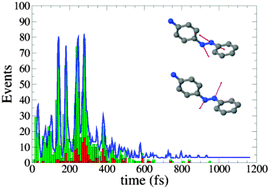Periodic decay in the photoisomerisation of p-aminoazobenzene
Abstract
Semiempirical OM2/MRCI surface-hopping simulations have been performed to study the E → Z and Z → E isomerisations of

* Corresponding authors
a
Max-Planck-Institut für Kohlenforschung, Kaiser-Wilhelm-Platz 1, 45470 Mülheim an der Ruhr, Germany
E-mail:
thiel@kofo.mpg.de
Fax: +49 208 306 2996
Tel: +49 208 306 2150
b Institut für Theoretische Chemie und Computerchemie, Heinrich-Heine-Universität Düsseldorf, Universitätsstr. 1, 40225 Düsseldorf, Germany
Semiempirical OM2/MRCI surface-hopping simulations have been performed to study the E → Z and Z → E isomerisations of

 Please wait while we load your content...
Something went wrong. Try again?
Please wait while we load your content...
Something went wrong. Try again?
J. A. Gámez, O. Weingart, A. Koslowski and W. Thiel, Phys. Chem. Chem. Phys., 2013, 15, 11814 DOI: 10.1039/C3CP51316E
To request permission to reproduce material from this article, please go to the Copyright Clearance Center request page.
If you are an author contributing to an RSC publication, you do not need to request permission provided correct acknowledgement is given.
If you are the author of this article, you do not need to request permission to reproduce figures and diagrams provided correct acknowledgement is given. If you want to reproduce the whole article in a third-party publication (excluding your thesis/dissertation for which permission is not required) please go to the Copyright Clearance Center request page.
Read more about how to correctly acknowledge RSC content.
 Fetching data from CrossRef.
Fetching data from CrossRef.
This may take some time to load.
Loading related content
